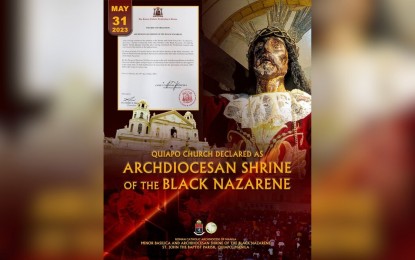
(Photo courtesy of Quiapo Church Facebook page)
MANILA – The St. John the Baptist Parish, commonly known as the Quiapo Church, has been elevated to the status of an archdiocesan shrine.
This came after Manila Archbishop Jose Cardinal Advincula approved the petition by Fr. Rufino Sescon Jr., rector of the parish.
“We hereby decree that the Minor Basilica of the Black Nazarene - St John the Baptist Parish (Quiapo Church), be conferred the title of the Archdiocesan Shrine of the Black Nazarene,” said the Manila archbishop in a decree dated May 10.
“By this Decree of Erection, We likewise grant to the said Archdiocesan Shrine of the Black Nazarene all the rights and privileges as embodied in the statutes which we also approve at the same time,” he added.
The Quiapo Church’s new status was announced Wednesday during a Mass presided by Fr. Reginald Malicdem, the archdiocese’s vicar general.
In his homily, the priest noted that the parish’s declaration as an archdiocesan shrine is “long overdue”.
“But for us devotees, whether there is a formal declaration, or none is made, this church is a real shrine because here we feel the presence of God,” he said.
The merits of petition was also approved in consultation with the community of the Minor Basilica of the Black Nazarene — St. John the Baptist Parish (Quiapo Church) and the Presbyteral Council.
A church, to be a diocesan shrine, among other requirements, must be a place of historical significance, prayer and pilgrimage for a special reason of piety.
A parish files a petition asking the bishop to canonically elevate the church.
The Quiapo Church is home to the image of the Black Nazarene. It annual procession which is held every January 9, is attended by millions of people especially devotees.
In 1987, St. John Paul II elevated the church as the Minor Basilica of the Black Nazarene because of its role in strengthening a deep popular devotion to Jesus Christ and its cultural contribution to the religiosity of the Filipinos. (PNA)
